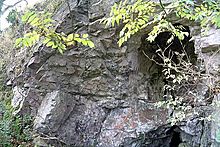|
|
|
|
Cheshire Wood CaveCave / Rock Shelter
|
||||||||||||||||||||||||
|
|
|
Images (click to view fullsize) |
|

|
Fieldnotes |
|
|
Cheshire Wood Cave is located on a high crag at the top of the woods, about 15ft below the ridge line. Access is pretty tricky from below although if you have a head for heights approaching the cave from above is easier and was possibly the original way of entry. The mouth of the cave is large and impressive with a further crawl in the back of chamber. Getting a good photo of the cave was almost impossible such is the steepness of the slope below the cave mouth. |
25th October 2007ce Edited 1st May 2008ce |
Miscellaneous |
|
|
Details of site on Pastscape A cave in Cheshire Wood situated within a north-west facing limestone rock face, just below th top of precipitous slopes to the Manifold Valley. Excavations were undertaken between May and December 1959 by Keele University. The cave originally had a stream running through it with a pool at the entrance. Finds included the remains of two adults and two children plus an antler tine, a chert flake and potsherds identified by Stuart Piggott as Neolithic (Windmill Hill "type" ware). Iron age and Roman pottery was also found, the latter possibly associated with a hearth. Some 17th century pottery was also found. All finds are in Stoke-on-Trent Museum. SK 116536. Cheshire Wood Cave, excavated in 1959 by Keele University. The excavation revealed on the first occuption layer the remains of two adults and two children, pottery identified by S Piggott as probably Windmill Hill type Neolithic ware, animal bones and a deer tine. The next layer although occupied over a long period produced no litter or animal bones, but patches of charcoal suggesting hearths and a potsherd identified by S C Stanford as Romano-British. The layer above this yielded a fragment of pottery which could be Iron Age and an iron object, possibly a hinge-plate, on top of which was a thin clay floor and an occupation layer with pottery dating 1650-1700. The finds are in the City Museum, Stoke-on-Trent. (1) The cave in Cheshire Wood is situated at SK 11295328, within a north west facing limestone rock face, just below the top of precipitous slopes to the Manifold valley. It is 6.0m in width, 6.0m in height and 9.0m in depth, and displays evidence of recent excavation. Divorced survey at 1:2500. (2) -------------------------------------------------------------------------------- SOURCE TEXT -------------------------------------------------------------------------------- ( 1) The North Staffordshire Field Club transactions Emery, GT. Excavations in Falcon Low and Cheshire Wood Caves in the Manifold Valley 2, 1962 Page(s)35 ( 2) Field Investigators Comments F1 ASP 13-NOV-74 ( 3) edited by K Branigan and M J Dearne 1992 Romano-British cavemen : cave use in Roman Britain Oxbow monographs 19 Page(s)82 ( 4) by Keith Branigan and Martin J Dearne 1991 A gazetteer of Romano-British cave sites and their finds Page(s)11 |
 Posted by Chance
Posted by Chance4th August 2012ce |
| The cave was excavated in the 1950's by Emery and Mills. The finds included the disarticulated bones of what would have been 2 adults and 2 children along with an antler tine, animal bones, chert flakes and pottery from the Early Neolithic. Later Iron Age pottery was also recovered. |
25th October 2007ce Edited 25th October 2007ce |

